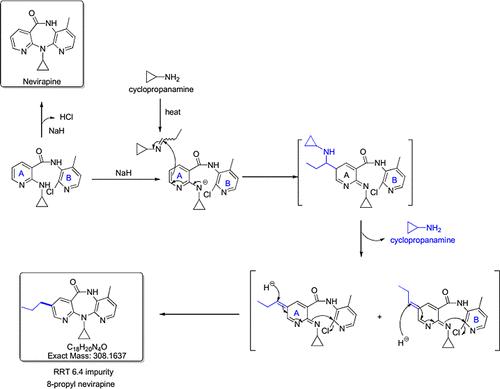当前位置:
X-MOL 学术
›
Org. Process Res. Dev.
›
论文详情
Our official English website, www.x-mol.net, welcomes your
feedback! (Note: you will need to create a separate account there.)
Identification of a Novel Process Impurity, Root Cause Investigation, and Its Control Strategy in Process Chemistry of Nevirapine API
Organic Process Research & Development ( IF 3.1 ) Pub Date : 2024-11-12 , DOI: 10.1021/acs.oprd.4c00377 Jinsheng Lin, Xiaojian Zheng, Dan Li, Huacui Hou, Xinlei Chen, Jianyang Jin, Xianhua Zhang, Wenbin Chen, Min Li
Organic Process Research & Development ( IF 3.1 ) Pub Date : 2024-11-12 , DOI: 10.1021/acs.oprd.4c00377 Jinsheng Lin, Xiaojian Zheng, Dan Li, Huacui Hou, Xinlei Chen, Jianyang Jin, Xianhua Zhang, Wenbin Chen, Min Li

|
An impurity eluting at RRT of 6.4 was observed during the HPLC testing of nevirapine (1) API for related substances. By using a strategy that combines LC-PDA/UV-MSn with NMR studies, the impurity was identified as 8-n-propyl nevirapine (2), a novel impurity that has not been reported in the literature. This impurity was sometime above 0.10% and difficult to be purged in the downstream of the existing manufacturing process of nevirapine, most likely due to its structural similarity to the API. Hence, this impurity should be controlled from the source of its generation in the process chemistry of nevirapine. During the early stage of the root cause investigation, two critical precursors to the impurity (2), (E)- and (Z)-N-propylidenecyclopropanamine (10 and 10′), were detected along with other relevant impurities, and based upon that, a probable formation mechanism of the impurity was proposed. In the late stage of the investigation, guided by the proposed mechanism, the process parameters of nevirapine manufacturing are optimized, under which the level of the impurity is reduced to 0.02% or below, while the yield of nevirapine is improved by 16%.
中文翻译:

奈韦拉平 API 工艺化学中新型工艺杂质的鉴定、根本原因调查及其控制策略
在对奈韦拉平 (1) API 进行 HPLC 检测相关物质时,观察到 RRT 为 6.4 的杂质洗脱。通过使用将 LC-PDA/UV-MSn 与 NMR 研究相结合的策略,杂质被鉴定为 8-n-丙基奈韦拉平 (2),这是一种尚未在文献中报道的新型杂质。这种杂质有时高于 0.10%,并且难以在奈韦拉平现有制造工艺的下游中清除,这很可能是由于其结构与 API 相似。因此,在奈韦拉平的工艺化学中,应从其产生的源头控制这种杂质。在根本原因调查的早期阶段,检测到杂质 (2) 的两个关键前体,(E)- 和 (Z)-N-丙基环丙胺 (10 和 10'),以及其他相关杂质,并基于此,提出了杂质的可能形成机制。在研究后期,在所提出的机制的指导下,优化了奈韦拉平制造的工艺参数,其中杂质水平降低到 0.02% 或更低,而奈韦拉平的收率提高了 16%。
更新日期:2024-11-13
中文翻译:

奈韦拉平 API 工艺化学中新型工艺杂质的鉴定、根本原因调查及其控制策略
在对奈韦拉平 (1) API 进行 HPLC 检测相关物质时,观察到 RRT 为 6.4 的杂质洗脱。通过使用将 LC-PDA/UV-MSn 与 NMR 研究相结合的策略,杂质被鉴定为 8-n-丙基奈韦拉平 (2),这是一种尚未在文献中报道的新型杂质。这种杂质有时高于 0.10%,并且难以在奈韦拉平现有制造工艺的下游中清除,这很可能是由于其结构与 API 相似。因此,在奈韦拉平的工艺化学中,应从其产生的源头控制这种杂质。在根本原因调查的早期阶段,检测到杂质 (2) 的两个关键前体,(E)- 和 (Z)-N-丙基环丙胺 (10 和 10'),以及其他相关杂质,并基于此,提出了杂质的可能形成机制。在研究后期,在所提出的机制的指导下,优化了奈韦拉平制造的工艺参数,其中杂质水平降低到 0.02% 或更低,而奈韦拉平的收率提高了 16%。


















































 京公网安备 11010802027423号
京公网安备 11010802027423号